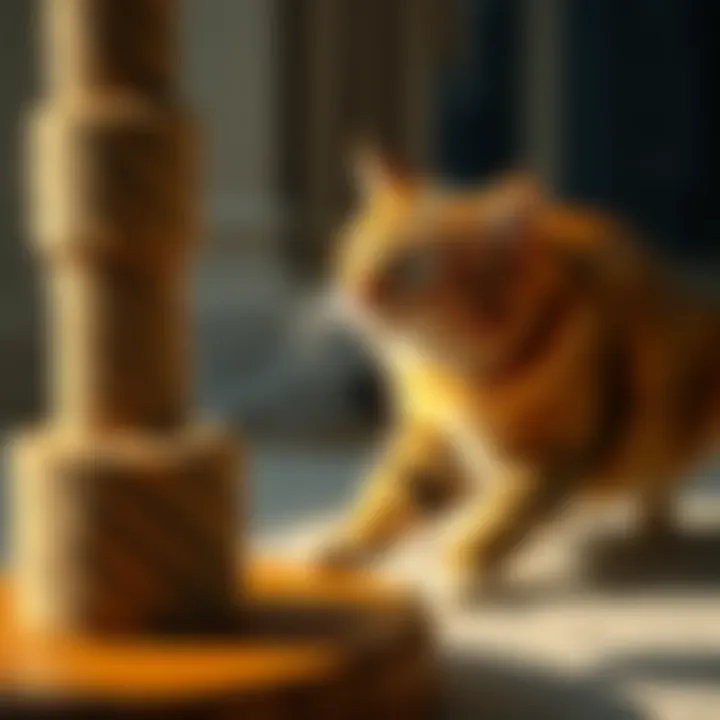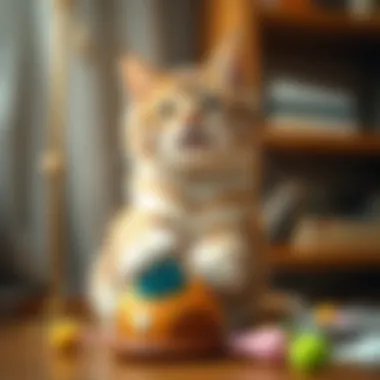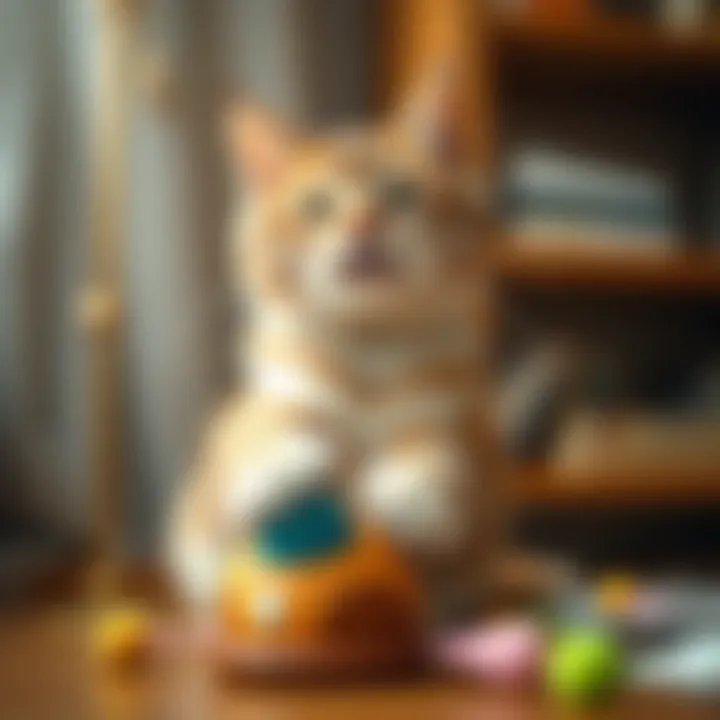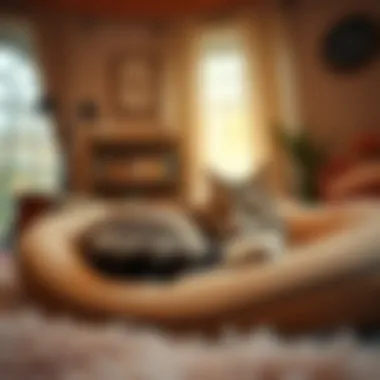Effective Strategies to Protect Furniture from Cats


Intro
Cats, those clever little companions, often have a knack for getting their claws into the things they shouldn’t. Anyone who has ever owned a cat can attest to the occasional, sometimes frustrating, habit of their furry friend clawing at the living room couch or the dining room chairs. Understanding feline behavior is crucial when it comes to protecting your furniture while keeping your pet happy. This article aims to equip you with both knowledge and practical strategies that address this common concern and facilitate a harmonious relationship between you and your cat.
Pet Care and Grooming
Maintaining your cat’s overall wellbeing goes a long way in curbing their destructive tendencies. One of the pillars of good pet care is grooming. Regular grooming does not just keep your cat looking spiffy; it also helps with their mental health. A well-groomed cat usually has fewer irritations and is oftentimes less likely to engage in destructive activities.
Importance of Regular Care
Regular grooming helps to establish a routine that your cat can rely on, making them feel secure. When they know that they will have a set time for pampering, they are less inclined to seek comfort through scratching furniture.
Grooming Techniques by Pet Type
While your adorable feline might not require the same grooming techniques as a dog, knowing what your specific breed needs is key. For instance, long-haired cats like Maine Coons require more frequent brushing to prevent matting. Here’s a breakdown:
- Short-haired cats: Brush every few weeks.
- Long-haired cats: Brush at least once a week.
- Sphynx cats: Check their skin regularly to ensure it's clean, as oils can build up.
Tools and Products Recommendations
You don’t need a toolbox full of fancy gadgets to groom your cat, but a few helpful items can make the process smoother:
- Furminator: This de-shedding tool works wonders for specific breeds.
- Cat brush: A simple bristle brush is ideal for quick grooming sessions.
- Nail clippers: Keeping their claws trimmed reduces the likelihood of them snagging on furniture.
Seasonal Care Tips
As the weather changes, so do the needs of your furry friend. During springtime, your cat may shed more fur, necessitating more frequent brushing. Conversely, keep in mind that winter can bring dry skin, so consider moisturizing sprays that are safe for cats to keep their skin healthy.
By ensuring your feline is healthy and well-groomed, you set the stage for good behavior.
Health and Nutrition
An often-overlooked aspect that greatly influences your cat's behavior is its nutrition. A balanced diet not only keeps them fit but can also prevent health issues that may lead to anxiety or destructive behavior.
Understanding Pet Nutrition
Feeding your cat a well-rounded diet tailored to their age and activity level is foundational. It’s critical to read labels and ensure that the food contains essential nutrients. Many after consuming low-quality food may become restless or more inclined to scratch or chew on furniture as a means of releasing pent-up energy.
"A well-fed cat is less inclined to take its frustrations out on your new sofa."
Common Health Issues by Species
Felines are commonly afflicted by certain health issues, some of which can be tied to their diet or inactivity. Obesity, for example, is rampant among indoor cats and can cause behavioral changes:
- Obesity: Can lead to lethargy and restlessness.
- Dental disease: Pain from dental issues can cause changes in behavior, including increased scratching.
Preventive Care and Regular Check-Ups
Regular vet visits are important. They can help catch health issues early, which may be influencing your cat’s behavior. Keeping vaccinations up to date and managing parasites also plays a significant role in maintaining optimum health.
Food and Dietary Advice
Consider a diet rich in animal protein and lower in fillers. You can consult with your veterinarian to find a suitable food. Some cats may even benefit from specialized diets to address behavioral issues or allergies that may lead to destructive scratching.
Behavioral Training
Understanding cat behavior can help with managing their tendencies to damage furniture, and that’s where behavioral training comes into play.
Basics of Positive Reinforcement
Instead of shouting or punishing your cat for scratching where they shouldn't, positive reinforcement can be far more effective. This approach involves rewarding good behavior. For instance, when your cat uses their scratching post instead, treat them immediately with a small snack or praise.
Training Techniques Users Can Apply
Start by placing scratching posts close to the furniture pieces your cat tends to attack. Use a catnip spray on these posts to lure them. Gradually redirect them over time by rewarding them when they use the post instead of the couch.
Managing Behavioral Issues
If your cat continues to claw furniture despite your efforts, consider consulting a professional animal behaviorist. They can provide tailored techniques suitable for your specific cat.
Importance of Socialization
Cats thrive on social interaction. By engaging your cat more frequently, you can alleviate boredom, which is often a source of unwanted behaviors. Playtime with a laser pointer or plush toy can help expend some of that pent-up energy.
Engaging Activities and Enrichment
Cats, by nature, are curious creatures. Providing them with engaging activities can significantly decrease the likelihood of them taking out their boredom on your furniture.
Fun Games to Play with Your Pet
Consider interactive toys that require problem-solving. Something like puzzle feeders can captivate their attention while keeping their minds sharp.
DIY Toys and Activities


Getting creative doesn't have to break the bank. Simple items like crumpled paper balls or cardboard boxes can provide hours of amusement for a cat. For a more interactive approach, try using strings or yarn (while supervising) as DIY entertainment.
Importance of Mental Stimulation
Regular mental challenges can help your cat feel fulfilled and less inclined to attack furniture. Rotate toys regularly to keep their interest piqued.
Outdoor Adventures and Exploration
If it’s safe to do so, consider training your cat to wear a harness. Outdoor exploration provides new scents and sights, making them more adventurous while satisfying their natural instincts.
Resources and Community Engagement
It’s always helpful to consult reputable sources for additional advice on keeping your furniture intact and maintaining a healthy pet.
Recommended Books and Websites
Books like "The Cat Owner's Manual" offer practical insights. Websites such as www.catbehaviorassociates.com and www.vet.cornell.edu can provide valuable information.
Forums and Groups for Pet Owners
Joining communities can enhance your own understanding. Websites like reddit.com offer spaces for pet owners to share their experiences and tips. You can find groups on Facebook to connect with fellow cat lovers.
Finding Local Services and Classes
Local pet stores and community centers may hold workshops or classes that cover various aspects of pet care and training. It’s worth checking in your area.
Encouraging Community Sharing and Contributions
Don’t shy away from sharing your experiences. Creating a supportive environment can benefit both experienced pet owners and first-time adopters.
As you can see, there are diverse strategies to keep both your cat and your furniture safe. By addressing your cat's needs and investing time in their care and behavioral training, you can foster a pleasant living space devoid of scratches and claw marks.
Understanding Cat Behavior
Understanding cat behavior is like having the key to a mysterious puzzle that can save your furniture from those tiny, yet determined claws. Grasping why cats scratch is crucial for pet owners, not just to protect hidden treasures like your sofa, but to enhance the well-being of your feline companion. Cats, by nature, are creatures of habit and instinct, and tapping into these natural behaviors can provide valuable insights into how to adapt your spaces for a more harmonious relationship.
The Instinct to Scratch
Natural behaviors of cats
Cats are a fascinating blend of predatory instincts and social behaviors. Scratching is a deeply rooted, natural activity. When cats scratch, it's not merely about sharpening their claws; it serves multiple purposes including marking territory and stretching muscles. This behavior can be traced back to their wild ancestors, who needed to maintain their claws for hunting and climbing. Understanding this can help owners see scratching not as a nuisance, but as a vital part of a cat's life.
The unique feature of this natural behavior is its dual role in maintaining physical health and allowing emotional expression. Hence, the contribution it makes towards a cat’s overall well-being is profound, as it helps channel energy and frustrations in a positive manner. When we consider this aspect of scratching, it becomes evident that offering alternatives will not only protect your furniture but also fulfill your cat's instinctual needs.
Why scratching is essential
Cat owners often overlook the importance of scratching beyond the surface. It is essentially integral for claw health. Scratching allows cats to remove the outer sheath from their claws, keeping them sharp and functional. Additionally, it releases pent-up energy which might otherwise lead to behavioral issues. The key characteristic of scratching being essential lies in how it intertwines with both physical maintenance and psychological health.
One could argue that providing appropriate scratching surfaces is bone deep in their health. Unfortunately, this understanding often gets brushed off, leading to frustration for both the owner and the cat. Integrating scratching posts and pads into your home becomes not just a remedy for damaged furniture, but a necessary aspect of maintaining a happy and healthy lifestyle for your pet.
Environmental Influences
Impact of stress on scratching
Stress can turn a cat into an unexpected wreaking ball of furniture destruction. When cats feel threatened or anxious, they may resort to scratching as a coping mechanism. It is important to recognize that various elements within a household can contribute to this stress. Changes like moving to a new place, the introduction of new pets, or even loud noises can set a cat on edge.
Identifying the key characteristic of this impact allows owners to grasp why a harmonious environment is necessary. Stress-induced scratching can wreak havoc on furniture and signify deeper emotional issues needing attention. By fostering a calm atmosphere and minimizing stressors, pet owners can not only protect their furniture but also stabilize their cat’s emotional state— a win-win.
The role of play and exercise
Integrating playtime into a cat’s routine can work wonders. Engaging your feline friend in regular exercise and stimulating activities can redirect their energy, reducing the urge to scratch furniture. The key characteristic of an active play routine not only satisfies their physical needs but also alleviates stress, keeping your home intact in the long run.
Interactive toys and engaging play sessions are excellent ways to tap into this instinct. Moreover, creating a unique feature in your environment that encourages active play reduces the reliance on inappropriate scratching spots. Ultimately, a well-stimulated cat is much more content, leading to a less destructive household.
"A tired cat is a happy cat, and a happy cat equals fewer scratched sofas."
By weaving these elements into the fabric of understanding cat behavior, owners can anticipate and fulfill their pet’s needs while safeguarding their beloved furniture from the stretching, clawing nature of their cats.
Identifying Problem Areas
Identifying problem areas is crucial when addressing the challenge of protecting furniture from cat claws. This section lays the groundwork for understanding where and why your cat tends to scratch. By pinpointing specific furniture types and recognizing your cat’s preferences, you can devise targeted strategies that effectively curb their scratching behavior. A thorough assessment of the areas your cat targets ensures that your preventative measures are tailored and practical, leading to better long-term outcomes.
Analyzing Furniture Types
Materials that attract scratching
Furniture materials play a significant role in attracting a cat’s claws. Fabrics like sisal, carpet, and even certain wood finishes can become magnets for your feline’s natural urge to scratch. Cats are drawn to textured surfaces that offer them a satisfying resistance when they claw. For instance, soft or fibrous materials can feel good under their paws, making it likely for them to prefer sofas clad in plush fabric over anything with a smooth finish, like leather.
Essentially, the characteristic that makes these materials appealing is their tactile quality. A practical advantage of this is that knowing which materials to avoid can guide your furniture choices. If you want to save your beloved chair from becoming shredded, steering clear of textured upholstery could save your investment.
However, certain advantages come with fabric fortunes; they can also be treated with protective sprays that make them less alluring to scratchers.
Commonly targeted furniture pieces
Some furniture pieces are more likely to attract scratching than others. Think about the places where your cat enjoys sharpening their claws: couches, dining chairs, and even curtains. These items typically have surfaces that combine a bit of give with durability, making them an attractive target for scratching.


The common characteristic of these pieces is their accessibility; they are usually positioned in central living areas. Because cats like to stake their claim, they see couches and chairs as prime real estate for their scratching habits. Addressing these hotspots allows pet owners to implement preventive strategies right where the action takes place. One unique feature here could be the presence of armrests or the bottom of chairs; often, these are preferred scratching zones. While these areas provide advantages for cats, they can be limits for the owners trying to maintain a scratch-free environment.
Understanding Cat Preferences
Observing scratching habits
Cats each have unique behaviors and quirks. By observing your cat’s scratching habits, you can gain insights into what drives them. Do they prefer vertical surfaces? Or are they tackling horizontal areas? Cats frequently scratch when they stretch, play, or even to mark territory, making this observation vital.
A telling characteristic of scratching observed is that cats often target the same areas repeatedly. This habit not only emphasizes their preferences but enables pet owners to gather data on where and how to redirect their behavior. Tracking these habits creates a clearer picture of the furniture and surfaces most at risk, enhancing the targeted strategies you can deploy. The downside, however, is that behavioral patterns can be unpredictable, making it essential to stay attuned to changes in habits over time.
Identifying favorite spots
Each cat has their favored spots, and these are often the same areas they go to when they need to stretch or relieve stress. Understanding your cat’s favorite spots helps in logical prevention planning. Cats might gravitate towards corners of rooms or the back of a couch, as these areas provide a sense of security and comfort.
A key characteristic of these spots is that they're usually high-traffic areas, drawing cats’ attention when they feel energetic or playful. The advantage of knowing your cat’s favorite haunts is that it opens the door for you to place scratching posts in close proximity. This not only diverts attention from your furniture but also fulfills their instinctual need to scratch. Nonetheless, it can be tricky; if the post's not appealing enough, your efforts might fall flat. Hence, aligning their preferences with appropriate scratching items is paramount in ensuring the success of this strategy.
Preventative Approaches
Preventative approaches are essential for maintaining a harmonious living space with our feline companions. By setting up the right environment and tools, cat owners can significantly reduce the chances of furniture damage, which not only keeps the home looking good but also makes life easier for both the pet and the owner. Prevention is about understanding cat behavior and making small adjustments to cater to their natural instincts. This proactive way of thinking can save both time and frustration later on.
Utilizing Cat Scratchers
Types of Scratching Posts
There’s a smorgasbord of scratching posts available, and each type serves a unique purpose. Some popular options include vertical, horizontal, and even angled designs. A vertical scratching post is often favored since it mimics the natural tree trunks that cats love to claw, making it an attractive choice. Also, covering these posts with materials like sisal rope or cardboard can boost their appeal and enhance scratch satisfaction. Conversely, those who dwell in small spaces might prefer horizontal scratchers, which can tuck away under a sofa or in a corner easily.
What’s crucial about these posts is their durability. It’s crucial to invest in sturdy scratchers that won’t crumble or tilt during enthusiastic scratching sessions. While not every cat will initially take to a scratching post, those that are designed with attention to element and function are generally more appealing. They can attract the cat's attention better and eventually lead them away from your beloved chair.
Location and Accessibility Considerations
Placement is half the battle when it comes to scratching posts. For the posts to be effective, they need to be accessible to cats when they feel the urge to scratch. Positioning them near areas where your cat loves to lounge can enhance usefulness. For instance, if you often find your feline friend stretching near the sofa, placing a scratching post nearby could help to divert their focus.
Additionally, consider the height of the post. Cats love to climb, and a post that’s more than a few feet tall can draw their interest more than a low one. However, it’s essential to consider safety too. The post should be securely built to prevent tipping over when your cat’s leaping into action. Balancing accessibility with safety ensures a better chance that the cat will use the post instead of the furniture.
Altering the Environment
Furniture Protection Ideas
Protecting furniture can involve both strategic planning and clever use of materials. Furniture covers can act as a barrier between claws and upholstery, but, let's face it, not everyone wants a protective sheet draped over their precious couch at all times. Instead, consider using furniture-safe sprays that create a slick surface on fabrics. These sprays aren’t harmful to your cat but can dissuade them from scratching. Another option is placing double-sided tape on the corners of your furniture. Cats generally dislike the sticky feeling on their paws, prompting them to rethink attacking that armchair.
What’s great about these protection ideas is that they can be temporary or long-term solutions depending on your cat’s scratching habits. While some owners might find these coverings too industrial-looking, they certainly prevent irreversible damage.
Creating a Feline-Friendly Space
To foster environments conducive to your cat’s needs, it’s crucial to embrace their instincts. Creating an area filled with various climbing spots and cozy napping hideaways can greatly reduce errant scratching. For instance, cat trees or multi-level condos not only provide entertainment for your cat but also offer alternatives to your furniture that they can explore at leisure. You could also incorporate some soft, fabric-lined boxes that serve as cozy hideaways.
Essentially, the more enriched the space for your cat, the less they’ll see your beloved couch as a scratching post. However, it’s important to regularly rotate or add new items to keep your cat engaged.
Emitting Deterrents
Safe Scents and Sprays
Some scents are simply unappealing to cats, and utilizing this knowledge can deter them from damaging specific areas. Citrus scents like lemon or orange are often off-putting to many felines, making citrus-scented sprays an effective option for keeping your furniture safe. Spraying these around your couch or on your curtains can act as a deterrent. However, it’s handy to ensure these products are actually safe—for instance, avoiding anything too strong which could upset their sensitive noses.
This technique is favorable because it actively utilizes the cat’s senses as a natural means of discouraging behavior without resorting to physical punishments.
Sound and Motion Devices
The final approach is to employ sound and motion devices, which can make use of technology to protect your home. Devices that emit a loud noise when the cat approaches an area designated for scratching can startle them and effectively dissuade further attempts. While this may seem harsh, most cats learn quickly that certain areas are off-limits.
Moreover, devices that respond to motion can release air puffs or harmless bursts of spray to send a clear signal without causing harm. These solutions can be effective, especially in maintaining furniture integrity in a household with larger numbers of cats. However, pairing these devices with proper training methods ensures they understand why scratching the furniture is a no-go.
Redirecting Scratching Behavior
Redirecting a cat's scratching behavior is an essential strategy to reduce the chances of furniture damage. Cats have an innate drive to scratch, and rather than trying to eliminate this behavior, the goal is to channel it into more appropriate outlets. Not only does this protect your belongings, but it also respects your feline's natural instincts. When done correctly, redirecting can foster a healthier relationship between you and your pet, making for a happier household.
Training Techniques
Positive reinforcement methods
Positive reinforcement methods involve rewarding a cat for displaying desired behaviors rather than punishing them for unwanted behaviors. This approach centers on encouraging your cat whenever it uses the designated scratching surfaces instead of furniture. One key characteristic of this method is its focus on rewards, such as treats or praise, which can encourage repeat behaviors. It's a popular choice because it relies on positive associations rather than fear.
A unique feature of positive reinforcement is that it builds trust between you and your cat; they learn that good behavior yields tangible rewards. However, one point to consider is that maintaining the reward system may require consistency. Without ongoing reinforcement, your cat might revert to the old habit of clawing the couch. Nevertheless, the long-term advantages of a well-rewarded pet can significantly outweigh the temporary challenges.
Gradual redirection to appropriate items
Gradual redirection to appropriate items is a tactic that involves slowly introducing cats to suitable scratching alternatives. This approach combines patience with persistence. It focuses on familiarizing your cat with scratching posts or pads over time, allowing them to understand that these items are their new designated scratching zones. A significant characteristic here is the gentle transition it offers; it doesn’t force the change but rather encourages it.
This method proves itself beneficial as it aligns with the cat's natural curiosity and instincts. By slowly introducing alternatives, you're allowing your pet to explore these new textures in their own time. Unique to this approach is the ability to set up different scratching materials in various parts of your home, catering to your cat's preferences while ensuring they gravitate away from your furniture. Of course, this does come with the disadvantage of requiring a bit of time and observation; not every cat will take to their new scratching surfaces immediately. Yet, with commitment, the outcome can be quite rewarding.
Using Clicker Training
Basics of clicker training for cats


Clicker training for cats is a method highly regarded in the animal training community. It is based on the principles of operant conditioning, using a small handheld device that makes a clicking sound to mark the desired behavior immediately. One of the attractive aspects of this method is its clarity; the sound signals to the cat that they have done something right. This clarity is crucial for reinforcing positive scratching behavior.
A unique feature of clicker training is it allows for precise timing, making it easier for your furry friend to connect the click with their action. This technique is particularly effective because it makes learning feel like a game, engaging the feline in a fun way. However, a downside to consider is that new clicker trainers may find it initially challenging to coordinate clicking and treating simultaneously, but with practice, it becomes quite manageable.
Linking the click to desired behavior
Linking the click to desired behavior involves associating that clicking sound with a specific action, in this case, scratching the designated surface. This connection is essential for effective communication between you and your pet. A key characteristic of this method is that it strengthens the link between the behavior and the reward, helping your cat associate scratching where you want them to with positive feedback. This clarity can significantly assist in achieving the goal of protecting your furniture.
This technique's distinguishing feature is the immediate feedback it provides; since the click occurs at the moment of the desired behavior, it can lead to quicker learning. Nevertheless, the challenge stems from being consistent with both clicks and rewards. If you neglect this consistency, your cat may become confused about what behavior is being rewarded. In the grand scheme, however, this technique often leads to a deeper understanding between you and your cat, ultimately creating a more harmonious living environment.
Maintenance and Monitoring
Preventing cats from turning your beloved furniture into their scratching post requires ongoing attention, not just a one-off attempt. Maintenance and monitoring serve as the backbone of a proactive approach, ensuring that the strategies are not only implemented but also adjusted as necessary. It’s crucial to recognize that feline behavior is not static; rather, it evolves. Therefore, consistent oversight can help pet owners effectively adapt their approaches based on real-time observations and outcomes.
Consistent Observations
Documenting Scratching Patterns
When it comes to managing a cat's scratching habits, documenting patterns can’t be overstated. Observing where, when, and how often your cat scratches helps in identifying specific triggers and problem areas. For instance, if you notice your cat is more prone to scratching after playing or during stressful situations, this insight can provide a pivotal rationale for the types of products or prevention strategies you might deploy.
The key characteristic here is the systematic approach to recording these observations, making it a beneficial tool for understanding your cat’s behavior. The unique feature of this documentation lies in its capacity to highlight trends over time, which can reveal hidden preferences or anxieties that may be contributing to destructive behavior. However, one must be cautious not to let the documentation become overwhelming or tedious, as this could lead to burnout in monitoring.
Adapting Strategies as Needed
Simply noticing scratching issues is merely half the battle; adapting strategies based on those observations is where the magic happens. The ability to change your approach to prevention based on documented patterns is vital for achieving a remedy. For instance, if a particular scratcher you bought isn’t being used, try relocating it to a zone your cat frequents.
The key characteristic of this adaptability is its flexibility, allowing pet owners to refine their strategies in tune with their cats’ behavior changes. This makes it a popular choice for those looking to cultivate a harmonious environment. The unique element here is that it fosters a sense of responsiveness rather than rigidness in techniques. That being said, it may take time to figure out the most effective strategies, but persistence pays off in the long run.
Adaptation of Techniques
Evaluating Effectiveness Over Time
An important factor in ensuring that your strategies are impactful is evaluating their effectiveness through time. This requires deliberate reflection on what measures are working and which are falling short. Indicators might include a reduction in scratches on furniture or increased use of scratching posts.
The essence of evaluating effectiveness lies in its objective assessment, allowing for data-driven decisions rather than assumptions. It offers a more thorough understanding of what resonates with your cat, thus making it a favored tactic among discerning pet owners. A downside, however, can include the discomfort of confronting the reality that some strategies may need to be entirely reworked, which could take additional time and resources.
Making Adjustments to Various Approaches
Just as no two cats are alike, no single strategy works universally. Making adjustments might mean revisiting products, repositioning furniture, or incorporating new interactive playtime routines. It emphasizes a customized approach, where every detail tweaks to better suit your pet's preferences and behaviors.
This characteristic fosters a sense of ongoing refinement, where solutions evolve alongside your cat. It can also enrich the owner-pet relationship by ensuring that your cat’s needs are being monitored closely and accommodating to their wishes. One caveat here is that constant adjustments can be overwhelming, leading to indecision in pet owners, which often disrupts the process. Therefore, balance and simplicity should be maintained through this approach.
Remember: Monitoring and maintenance serve not just to manage furniture but to enhance your relationship with your feline friend.
When to Seek Professional Help
Sometimes, no matter how much effort you put into protecting your furniture, you might find your cat's scratching remains relentless. In such cases, knowing when to bring in the experts becomes key. Consulting professionals can offer invaluable insights and tailored strategies to solve your predicament, ultimately ensuring a less frustrating experience for both you and your feline friend.
Recognizing Behavioral Issues
Persistent scratching behavior
Persistent scratching behavior is not just a nuisance; it's a clear signal indicating that your cat may be experiencing unresolved issues. Cats are creatures of habit, and if their scratching habits seem to escalate or become more frequent, it’s a call for attention. Often, this behavior can stem from stress, anxiety, or boredom. One primary characteristic of persistent scratching is that it becomes a daily routine and not just an occasional episode. This makes it a crucial topic within this article.
The important thing to note is that persistent scratching can lead to long-term harm, both to your furniture and your cat’s paws. While some may think of it merely as an annoying habit, it can indicate deeper behavioral problems. Recognizing this unique aspect is essential as it shapes your approach—ignoring it could mean that whatever underlying issue exists is only going to grow.
Signs of stress requiring intervention
Cats are notoriously elusive when it comes to expressing their discomfort or stress. Sometimes, that discomfort may manifest in the form of scratching. Key indicators of stress include changes in eating habits, hiding more frequently, or aggressive behavior. When you notice these signs accompanied by persistent scratching, it's time to take a closer look.
This characteristic makes recognizing signs of stress an essential part of maintaining a harmonious home. If these signs are ignored, they can lead to significant behavioral changes that could impact your cat’s overall health. Prevention is always better than cure, and understanding these symptoms early on can provide an opportunity to address any underlying issues before they escalate.
Finding a Specialist
Consulting with veterinarians
When all else fails, consulting a veterinarian can uncover hidden health issues that might be galvanizing your cat’s scratching behavior. For instance, dermatological problems or pain could compel a cat to scratch more frequently. A veterinarian's role is not limited to physical examinations; they can provide behavioral insights as well.
One key aspect of consulting a vet is their expertise in distinguishing between normal and concerning behaviors, and when you should consider solutions that might include medications or behavioral therapy. This specialized knowledge makes it a reliable avenue for you to pursue in this article.
Behaviorist options and their approaches
Behaviorists go a step further by focusing solely on the emotional and psychological aspects of your cat's behavior. This is no cookie-cutter solution; behaviorists craft a tailored approach that fits the unique needs of your pet. They analyze various factors influencing your cat's actions, often recommending environmental changes, new training techniques, or behavior modification strategies.
While consulting a behaviorist may come at a cost, the customized strategies that come from this process can be well worth it. They offer a nuanced understanding of your pet's behavior, which is often absent in more general advice. Understanding behaviorists' approaches, therefore, presents a significant advantage for pet owners struggling with persistent scratching issues.
Understanding when to seek professional help is crucial for maintaining not just your furniture, but also the well-being of your feline companion.
Summary and Ending
Understanding how to safeguard your furniture from feline claws is no small feat. As a cat owner, finding a balance between maintaining your home's aesthetic and prioritizing your pet's instincts is crucial. This article has delved into many strategies for preventing cats from damaging furniture, and it's important to remember a few key points about these solutions.
Key Takeaways
Recap of prevention techniques
Taking proactive steps to prevent your cat from scratching furniture can include various techniques such as providing scratching posts, using deterrents, and altering the environment. These methods are not only beneficial in curbing destructive behaviors but aimed at enriching your cat’s life. Providing adequate scratching posts in strategic locations can cater to your cat's natural instincts while saving your furniture from potential damage. The main characteristic of this strategy is proactivity; cat owners can take charge before scratching escalates into a serious problem. One of the unique features here is diversity in scratching options—different types of scratching materials cater to varied feline preferences, making it crucial to observe your cat's choices. The benefits of employing these techniques can lead to a more harmonious environment, both for your furniture and your cat’s wellbeing.
Importance of patience and consistency
When integrating these methods into your cat management strategy, one must remember that patience is key. Behavioral changes in animals often take time to manifest, and consistency plays an equally important role in reinforcing good habits. A repeated effort in redirecting your cat's scratching behavior towards accepted items can yield positive results. This aspect emphasizes the necessity of being present—actively engaging with your cat rather than expecting immediate success. One unique feature to note is that this process is not a quick fix; rather, it is a gradual evolution towards better scratching behavior. While initial setbacks are common, the long-term advantages of a committed approach can substantially elevate the quality of life for both you and your pet.















